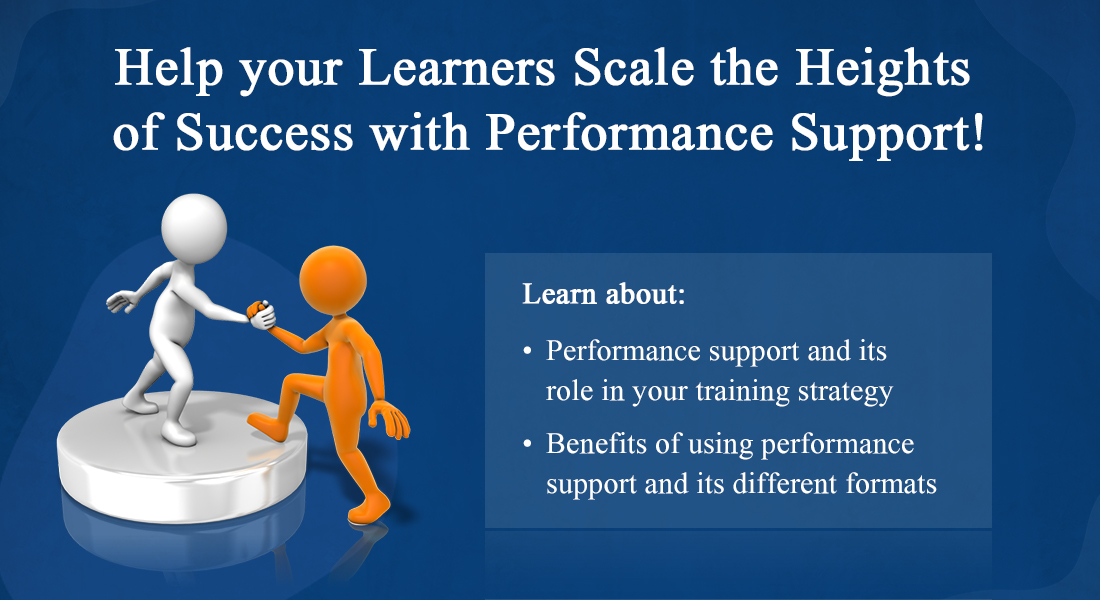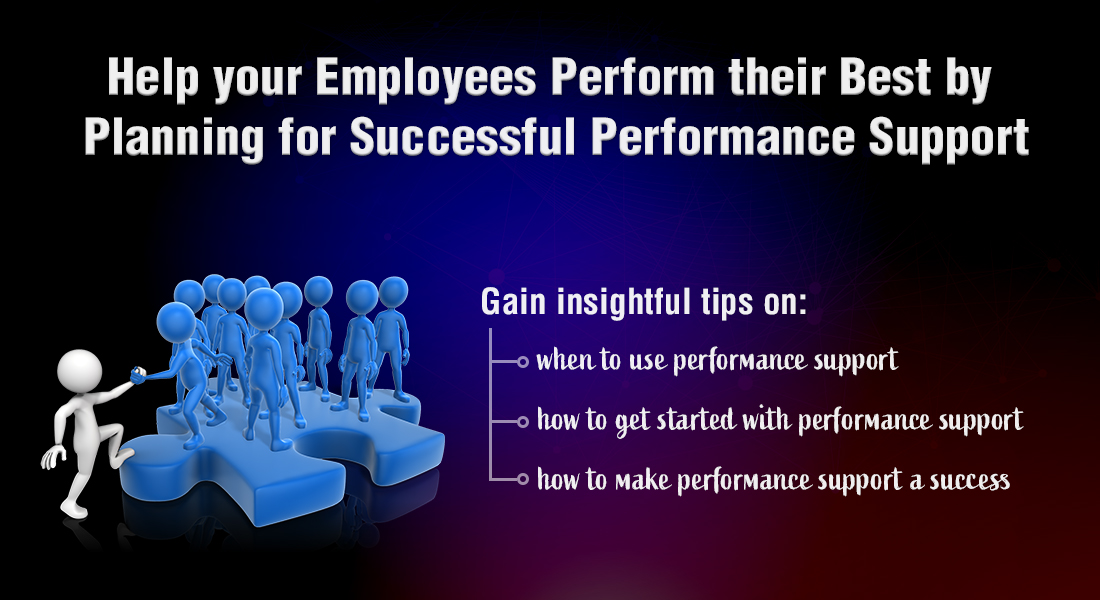Performance Support in Corporate Training (Part1): The What and the Why

Did you know that 49% of employees prefer to learn at the point of need? Completely understandable considering the forgetting curve, right? I mean, why waste time learning every bit of information when they know there’s simply no way they can remember everything. But the more important question is, “How do they look for information?” Do they ask their neighbor? Flip through training manuals? Ask the almighty Google? But all these options are both time-consuming and not very reliable. This is why performance support tools come in handy in corporate training when employees need information exactly at their moment of need.
Getting Started with Performance Support in Corporate Training
1. Performance Support: Benefits
- Is easy to access, saves time
- Empowers learners
2. Performance Support: Formats
- Mobile Apps
- Videos, Animations, Infographics
- Podcasts/Webcasts
Want to learn the secrets of online training and become an eLearning champion? Register for a free webinar!
Most of us think we know everything about performance support. But do we really?
For those of you wanting more information on performance support in employee training, I am going to discuss what performance support is, how it fits in the overall corporate training plan, what its benefits are, and what the different formats of performance support tools (PSTs) are.
Excited? Let’s get started then!
What is Performance Support and Where Does it Fit in your Corporate Training Strategy?
Performance support a.k.a. just-in-time learning (or job aids) is all about providing instant training solutions to employees at the moment of need.
You shouldn’t confuse your performance support tools with formal training. If formal training is the protagonist of your training strategy, performance support tools are the dependable side-kicks without whom success is not always guaranteed.

Here is how you can better understand and differentiate between formal training and performance support.
| Formal Training | Performance Support | |
| Purpose | To instruct learners | To help learners perform |
| Workflow | Requires dedicated time away from work | Learning happens in the flow of work |
| Learning Design | Structured learning | Incidental learning |
| Goal | To gain a new skill or fill knowledge gaps | To reinforce learned information |
Benefits of Performance Support
What was the headline on the front page of the newspaper you read today during breakfast?
What about the interesting little article you read three days ago? And the book you read last month? Can you remember?
Don’t worry if you can’t immediately recall this information – your brain and memory are working normally. We constantly struggle with our ability to absorb new information and the tendency to forget as depicted in Ebbinghaus’ Forgetting Curve. Without repetition and reinforcement, knowledge retention will be an impossible feat. This makes learning a continuous and never-ending process. And also why performance support is so important in corporate training.
Performance Support is essential if you want your learners to perform their best in their jobs. Here are a few more benefits of performance support that you can’t ignore.
Performance support tools (PSTs):
- Enable easy access to information. Since PSTs are designed to meet a single specific need, they are easier to use and apply.
- Save a lot of time by providing a quick resolution to the problem that the learner is facing, enhancing productivity.
- Empower learners to manage their work and resolve problems on their own by reducing their dependency on senior employees and colleagues.
- Makes the onboarding of new employees faster by providing them assistance every step of the way as they start their jobs.
- Can be used to provide immediate information updates to learners like new product features, upgrades, change management, or new standard operating procedures (SOP).
Different Formats of Performance Support Tools (PSTs)
1. Mobile Apps
Do you have employees working off-site? If yes, mobile apps are the best performance support solutions you can provide them. Mobile apps can either be tools to help employees perform a specific task or can be a platform to enable learners to access just-in-time learning at their moment of need.
2. Microlearning Videos
Videos have always been at the top at conveying information in a way that is both effective and engaging for learners. Using microlearning videos for performance support is like the icing on a cake. Since microlearning deals with only one learning objective per module, learners will be able to access the exact information or solution they need without having to flip through a long manual or sit through an entire eLearning course.
- Interactive videos can be used to deliver quick but well-rounded information to learners.
- How-to Videos are ideal to demonstrate processes and procedures for learners (e.g. the steps to operate a new product or use a new software).
- Expert videos can be used to deliver a message from senior leadership or pointers from subject matter experts (SMEs) for better performance.
3. Podcasts/Webcasts
These can be audios or videos, depending on your learners’ preferences, serving as downloadable references that they can watch/learn on-the-go.
4. Animations
In training programs where it is not possible to show real-life videos, you can make use of animations to show complex processes or concepts in a way that is engaging and easy for learners to understand. You can make use of text animations or whiteboard animations to deliver performance support to employees.
5. Infographics
Infographics are impactful visual images that can be used to represent complex information in a simple manner. They readily grab learners’ attention and can deliver needed information without much fanfare.
6. Flipbooks & Interactive PDFs
You can use flipbooks and interactive PDFs to provide learners a guide to help them during their job tasks. They are best at engaging learners when the content is a bit lengthier and text-heavy. The clickable buttons, embedded images and videos, built-in dictionary and page search make it appealing for learners as well as easy to navigate.
Summing it Up!
So… did you enjoy learning more about performance support? I hope this blog gave you some useful information and you’re eager for more. In the next part of this blog, I will be discussing how to get started with performance support and what it takes to create successful performance support tools.
Till then, I hope you’ll enjoy going through our eBook on microlearning and how it can boost your employees’ performance.




